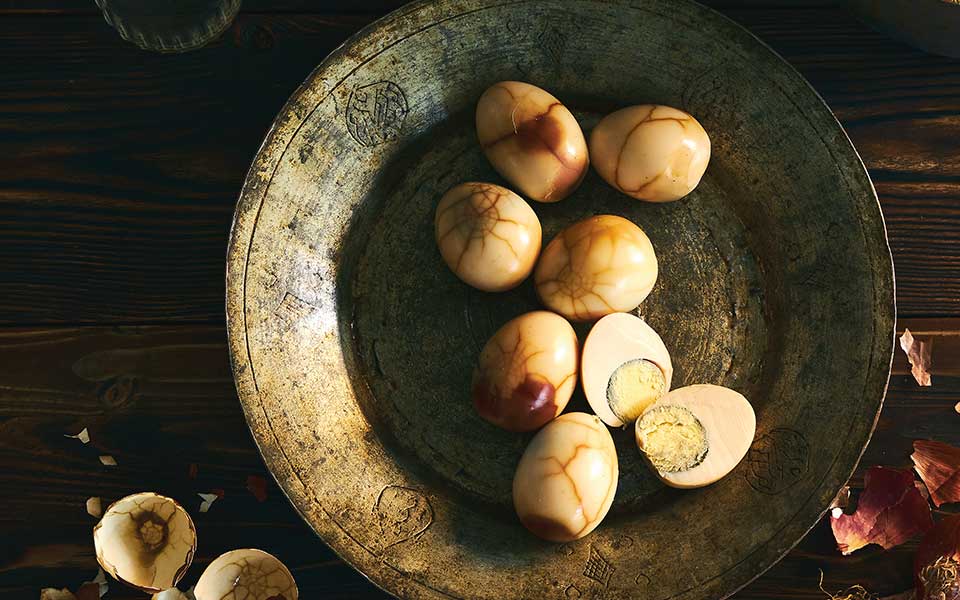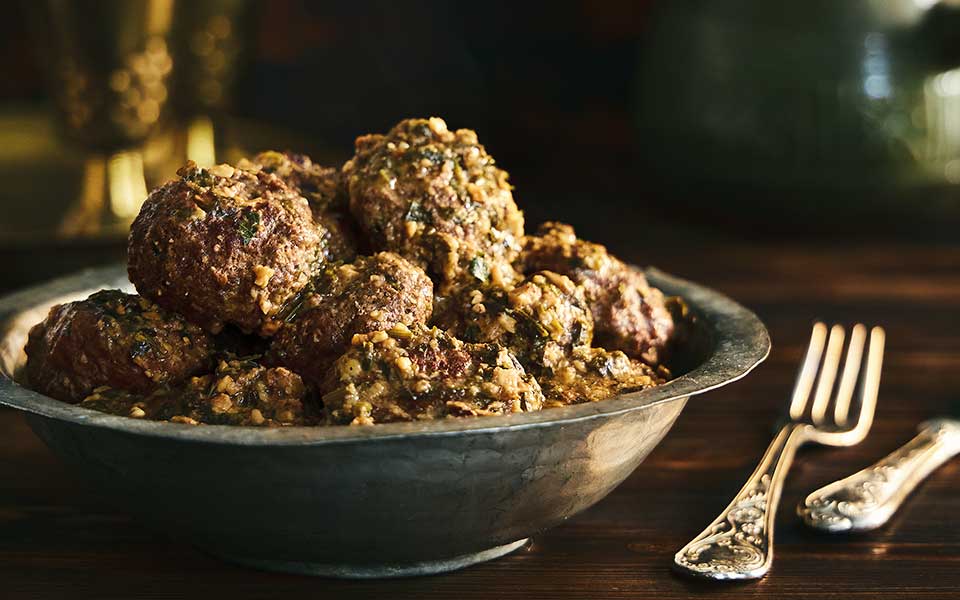“I became intoxicated with the distinctive aroma coming from the Jewish homes of Thessaloniki – a mixture of rosewater, sautéed onions, and ripe melons – aromas that I recall with nostalgia.”
– Ilias Petropoulos, quoted in “Thessaloniki 1850-1918” by Gilles Veinstein
For centuries, the streets of Thessaloniki were filled with the sensuous fragrances of the Iberian peninsula, thanks to the cuisine of the Sephardim, the Jews who’d been expelled from Spain in 1492 and welcomed to the Ottoman Empire by Sultan Bayezid II.
It had been an astounding arrival. Both in number and in sheer sophistication, the Sephardim overwhelmed the local Romaniote Jewish population. The culture and the language that the newcomers carried with them brought a slice of Spain to the Ottoman Empire, with a cuisine to match.
And what a cuisine it was, the very essence of the Sephardim – vibrant, sophisticated and as sunny as the world they’d left behind. Generations of gracious living in Muslim Spain had shaped an aromatic and complex gastronomic tradition full of delicate delights and elaborate preparations.
Just as the Jews of Spain had lived for generations in convivial harmony with their neighbors on the Iberian Peninsula, so did they continue to do so in Thessaloniki. In his “Cookbook of the Jews of Greece,” Nicholas Stavroulakis conjures scenes of leisurely afternoons in the hammam (the baths) or the haremlik (the women’s private quarters), where Jewish and Muslim women would share stories, songs and recipes.
Pilafs, stuffed vegetables, new sweets and tasty milk puddings added another rich layer to the complex culinary legacy of the Sephardim.
This glorious cuisine is celebrated in “A Taste of Sephardic Thessaloniki,” a collection of family recipes by Nina Benroubi, one of Thessaloniki’s few Holocaust survivors – the city lost 96 percent of its Jewish population in WWII – and a woman with memories of the genteel life of pre-war Thessaloniki.
Her detailed reminiscences – together with those of her co-author, the restaurant critic and food writer Epicurus – vividly evoke a vanished world. In these authentic recipes, one tastes that world still. Food and memory have always been linked for the Jews, and cuisine continues to play an integral role in preserving Jewish cultural identity.

© Theodosis Georgiadis

A SEPHARDIC MENU
When chef Konstantinos Markou came across this book, the dishes and the stories resonated with him, particularly as his restaurant, Akadimia (3 Aghiou Mina, Thessaloniki, Tel. +30 2310.521.803), is located in the heart of a historically Jewish neighborhood.
Markou introduced a Sephardic menu, available by pre-arrangement, amid a growing interest in Thessaloniki’s Sephardic culture. The new option was well received, particularly since this cuisine isn’t often commercially available; in the past, Sephardic cooking belonged to a largely private sphere, difficult to find outside of homes.
Benroubi, too, came to Akadimia and enjoyed both the food she had and the idea that others would be able to share in the flavors of her youth.
Some aspects of Sephardic cuisine live on in what’s traditionally considered “Greek” food. In the almond paste delight known as amygdalota, we taste the martsapades (marzipan) of the Sephardic kitchen.
And consider the eggplant; in “A Taste of Sephardic Thessaloniki,” the authors note that the beloved merendjéna of their homeland is “for the Sephardic Jews what the potato represents to the Ashkenazi – the alpha and the omega of their culinary alphabet.” Today, it’s impossible to imagine Greek cuisine without that wondrous vegetable.
Below are three recipes from this cuisine that is as rich and sophisticated as the culture that created it.

© Theodosis Georgiadis, Food styling: Stavroula Foutsa
HUÉVOS HAMINÁDOS
These delicious eggs – whose name derives from the Ladino word hamin (oven) – make ingenious use of scant resources; they’re made with the onion skins gathered over a week of cooking, and were traditionally nestled in the leftover ashes and fading embers of wood-burning ovens to bake overnight.
Today, as in this recipe, they’re left to simmer slowly on the stovetop. Coffee, tea leaves, and cinnamon sticks contribute both a rich flavor and their characteristic deep bronze shade.
The food itself has a meaning, as the egg in its shell symbolizes the cycle of life. What’s more, the eggs can be readied before Friday at sundown, then left to cook untended until Saturday morning, making them suitable for Sabbath preparation, when the lighting of fires or any other work is prohibited.
METHOD
Wash the eggs and place them with the remaining ingredients in a deep pot. Add water to cover. Place on medium to high heat, keeping watch. Just before the water comes to a boil, cover the pot, turn the heat down to the lowest setting, and let the eggs simmer for 8 hours, topping up the water if necessary. Serve at room temperature.
INGREDIENTS
- 10 eggs, at room temperature
- 4 large handfuls of onion skins (from around 20 onions)
- 1 tbsp cooking oil
- 1 tbsp vinegar
- 1 tbsp finely ground coffee (Greek coffee)
- 1 tbsp tea leaves
- 2 cinnamon sticks

© Theodosis Georgiadis, Food styling: Stavroula Foutsa
BORREKITAS DE MERENDJÉNA (SMALL EGGPLANT PIES)
Saturday, the Sabbath, was particularly festive – a day of feasting and socializing. Joyous preparation went into enjoying the day of rest, including making a selection of delights to offer guests. Benroubi brings that gracious lost world of old Thessaloniki to life, describing the huevos haminados and the delicate borrekitas that visiting grandfathers and uncles would enjoy as they sipped ouzo on Saturdays.
As the eggplant reigns supreme in the Sephardic cuisine of Thessaloniki, borrekitas de merendjéna would have been among the most popular of the many small pies.
In addition to the traditional eggplant and feta in the filling, these have the colorful additions of roasted red peppers and minced parsley. The tender dough of this particular recipe comes together in an unusual way.
METHOD
For the dough
Put the oil and the water into a pot and bring to a brisk boil. Remove from the heat, add the flour and the yogurt, and stir until well blended. Cover the pot with a kitchen towel and set the dough aside to rest as you prepare the filling.
For the filling
Heat the oven to 180o C. Wash the eggplants, leaving them whole, and prick them a couple of times with a fork. Place in the oven and roast until softened, about 35-45 minutes. Let them cool, then scoop out the flesh and mash it with a fork. Add the remaining ingredients, mix and set aside.
Form the dough into balls about the size of a walnut, and shape each into a disk about half a centimeter thick. Place a spoonful of filling slightly off center on each disk, and fold the dough over it to form a half-moon. Trim the excess dough, using an inverted drinking glass, and pinch the edges to seal.
Place the pies on a well-oiled baking sheet. Beat the egg with a spoonful of water, and brush each pie with the egg wash. Bake in the middle of the oven at 180˚ C until golden.
INGREDIENTS
For the dough
- 1 cup of corn oil
- 1 cup of water
- 4 cups of flour
- 100 grams of yogurt (about ½ cup)
- 1 egg, for glazing the pies
For the filling
- 2 whole eggplants
- 400 grams feta, crumbled
- 1 red pepper, grilled, peeled and diced
- 2 tbsp chopped parsley
- 2 eggs
- 2 tbsp cooking oil
- Salt and pepper to taste

© Theodosis Georgiadis, Food styling: Stavroula Foutsa
KEFTIKÉS DE NOGÁDA CON MUÉSI PRISHIL (MEATBALLS WITH WALNUTS AND PARSLEY)
Kefitkes – croquettes or meatballs – figure prominently in Thessalonian Sephardic cuisine. There’s a wonderful variety of recipes, from vegetarian options to inventive mixes of vegetables and ground beef.
Walnuts, too, are a characteristic ingredient of Sephardic cuisine, in savory dishes as well as desserts. Here, they’re used in an inventive manner to enrich and thicken the sauce for this unusual and sophisticated dish.
Keftikes were a usual feature of the elaborate pre-war lunches that Benroubi describes. There would be a first course, such as pasta or fish, followed by a ladera course (vegetables simmered until meltingly tender in tomato and oil) and keftikes or perhaps a kokkinisto – a meat dish boasting a rich tomato sauce.
There were generally two salads, one with raw ingredients and one of boiled vegetables.
METHOD
Put the ground meat in a bowl, then dampen the bread slices, wring them out, and add them to the meat. Finely grate the onion and add it as well, along with the egg, a small amount of oil, and some salt and pepper. Mix lightly but thoroughly.
Heat a generous amount of oil over medium to high heat in a large frying pan. Shape the meat mixture into balls and fry them in the oil, turning as they cook so they brown evenly all over. Meanwhile, pass the walnuts and the parsley through a food processor; alternatively, crush them together using a pestle and mortar.
When the meatballs have been thoroughly browned, pour off some of the excess frying oil, if any remains, leaving a half centimeter in the pan. If the pan is dry, add oil until you reach the half centimeter mark. Then add a half-cup of water, the walnut mixture, and the dry breadcrumbs. Simmer gently until you have a thick sauce, adding more water if necessary, and then serve.
This article first appeared in the print issue Greece Is Thessaloniki 2020. The magazine, along with other past issues, is available for order at our eshop.
INGREDIENTS
• 750 grams ground beef
• 3 slices of bread, crusts removed
• 1 small onion
• 1 egg
• 1 tbsp cooking oil
• 200 grams walnuts, shelled
• Some parsley, finely chopped
• 2 tbsp fine dry breadcrumbs
• Salt, pepper
• Oil for frying












